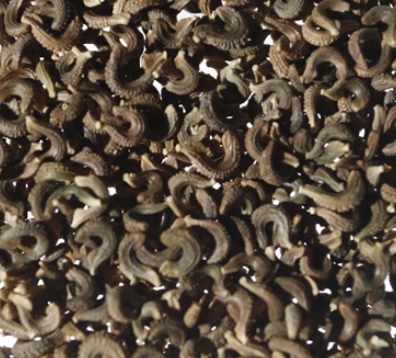Calendula Officinalis Flower Extract is derived from the flowers of the Calendula officinalis plant. Commonly known as Calendula Flower Extract, it is widely used in cosmetic and skincare formulations for its soothing, anti-inflammatory, and healing properties.
Chemical Composition and Structure:
Key Components: The extract contains various bioactive compounds, including flavonoids, triterpenes, carotenoids, and polysaccharides. Major phytochemicals include calendulin and flavonoids such as quercetin and astragaloside.
Structure: The chemical structure of flavonoids and triterpenes contributes to the extract’s anti-inflammatory and antioxidant benefits.
Physical Properties:
- Appearance: Typically appears as a yellow-orange liquid or powder, depending on concentration and formulation.
- Odor: Has a characteristic mild floral scent that is pleasant.
- Solubility: Soluble in water and organic solvents, making it suitable for incorporation into various cosmetic formulations.
Production Process:
- Extraction: The flowers of Calendula officinalis are harvested and processed using aqueous or organic solvents to obtain the extract. Common extraction methods include maceration and percolation.
- Purification: The extract is purified to remove impurities and concentrate the desired active ingredients.
- Formulation: The purified extract is incorporated into cosmetic products such as creams, lotions, and serums.
Applications:
- Cosmetics: Used in a range of skincare products for its soothing and anti-inflammatory properties. It is particularly effective in products designed for sensitive and irritated skin.
INCI Functions:
Fragrance. It plays a very important role in the formulation of cosmetic products as it provides the possibility of enhancing, masking or adding fragrance to the final product, increasing its marketability. It is able to create a perceptible pleasant odour, masking a bad smell. The consumer always expects to find a pleasant or distinctive scent in a cosmetic product.
Skin conditioning agent. It is the mainstay of topical skin treatment as it has the function of restoring, increasing or improving skin tolerance to external factors, including melanocyte tolerance. The most important function of the conditioning agent is to prevent skin dehydration, but the subject is rather complex and involves emollients and humectants that can be added in the formulation.
Perfuming. Unlike fragrance, which can also contain slightly less pleasant or characteristic odours, the term perfume indicates only very pleasant fragrances. Used for perfumes and aromatic raw materials.
- Skin Care: Incorporated into creams and lotions to relieve irritation and inflammation, improve skin hydration, and promote healing.
- Hair Care: Can be used in shampoos and conditioners for its calming and nourishing properties, helping to maintain a healthy scalp.
Environmental and Safety Considerations:
- Environmental Impact: The production of calendula extract is generally considered sustainable. It is important to use responsible harvesting practices to ensure environmental protection.
- Safety: Generally regarded as safe for topical application. However, like all botanical extracts, it should be used in accordance with established guidelines to avoid potential allergic reactions or skin irritations. Safety assessments are required for any new formulations or high concentrations.
Calendula (Calendula officinalis L.) is a very common annual plant in Mediterranean countries.
The extract of its flowers has interesting curative properties

The content of Calendula officinalis has interesting components: phenolic complexes such as flavonoids and, to a lesser extent, ethanol. These components have a demonstrated antioxidant activity (1) also for the presence of terpenes, in particular pentacyclic triterperpenes, Taraxasterol, Lupeol, alpha-amirin, beta-amirin (2), kaempferol and narcissine (3) an alkaloid also found in narcissus.
Medical
Due to components such as rutin and quercetin, Calendula extract has shown a potential role in the healing of ulcers in the diabetic foot (3) and in wound healing (4).

A phytochemical analysis on the composition of Calendula seeds showed that 28-O-β-D-glucopyranosyl-oleanolic acid 3-O-β-D-glucopyranosyl (1→3)-β-D-glucopyranosiduronic acid has, in adults, a powerful stimulant effect for the production of hyaluronic acid on normal human dermal fibroblasts, while another acid, oleanolic acid 3-O-β-D-glucopyranosyl (1→3)-β-D-glucopyranosiduronic acid, showed a stimulating activity of melanin biosynthesis (5).

Due to its numerous polyphenolic antioxidants, Calendula has been evaluated both in the laboratory and in clinical settings for use in the treatment and prevention of radiotherapy skin reactions with conflicting results (6).
An interesting application of Calendula concerns the sterilizing properties of its extract (7).
Cosmetics
Fragrance. It plays a very important role in the formulation of cosmetic products as it allows perfume to be enhanced, masked or added to the final product, improving its commercial viability. The consumer always expects to find a pleasant scent in a cosmetic product.
Skin conditioning agent. It is the mainstay of topical skin treatment by restoring, increasing or improving skin tolerance to external factors, including melanocyte tolerance. The most important function of the conditioning agent is to prevent skin dehydration, but the subject is rather complex and involves emollients and humectants.
Bibliografia_____________________________________________________
(1) Biological Activities of Asteraceae (Achillea millefolium and Calendula officinalis) and Lamiaceae (Melissa officinalis and Origanum majorana) Plant Extracts.
García-Risco MR, Mouhid L, Salas-Pérez L, López-Padilla A, Santoyo S, Jaime L, Ramírez de Molina A, Reglero G, Fornari T.
Plant Foods Hum Nutr. 2017 Jan 18. doi: 10.1007/s11130-016-0596-8.
(2) Bioaccessibility and Antioxidant Activity of Calendula officinalis Supercritical Extract as Affected by in Vitro Codigestion with Olive Oil.
Martin D, Navarro Del Hierro J, Villanueva Bermejo D, Fernández-Ruiz R, Fornari T, Reglero G.
J Agric Food Chem. 2016 Nov 23;64(46):8828-8837.
(3) A Prospective, Descriptive Study to Assess the Clinical Benefits of Using Calendula officinalis Hydroglycolic Extract for the Topical Treatment of Diabetic Foot Ulcers.
Buzzi M, de Freitas F, Winter M.
Ostomy Wound Manage. 2016 Mar;62(3):8-24.
(4) The Water Fraction of Calendula officinalis Hydroethanol Extract Stimulates In Vitro and In Vivo Proliferation of Dermal Fibroblasts in Wound Healing.
Dinda M, Mazumdar S, Das S, Ganguly D, Dasgupta UB, Dutta A, Jana K, Karmakar P.
Phytother Res. 2016 Oct;30(10):1696-1707. doi: 10.1002/ptr.5678.
(5) Zaki A, Ashour A, Mira A, Kishikawa A, Nakagawa T, Zhu Q, Shimizu K. Biological Activities of Oleanolic Acid Derivatives from Calendula officinalis Seeds. Phytother Res. 2016 May;30(5):835-41. doi: 10.1002/ptr.5589. Epub 2016 Feb 16.
(6) A Review of the Use of Topical Calendula in the Prevention and Treatment of Radiotherapy-Induced Skin Reactions.
Kodiyan J, Amber KT.
Antioxidants (Basel). 2015 Apr 23;4(2):293-303. doi: 10.3390/antiox4020293. Review.
(7) Production of Sterilizing Agents from Calendula officinalis Extracts Optimized by Response Surface Methodology.
Goktas FM, Sahin B, Yigitarslan S.
Int J Anal Chem. 2015;2015:789732. doi: 10.1155/2015/789732.
![]() Calendula Officinalis Flower Extract
Calendula Officinalis Flower Extract 




